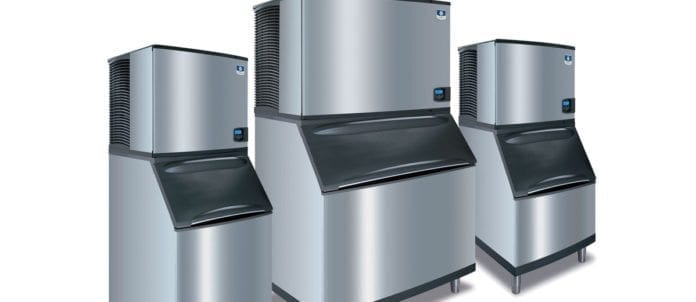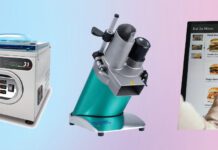Choosing the best ice-making equipment is often a delicate balance between form and function. Mixologists might place more emphasis on the aesthetics of the ice itself, a seafood restaurant owner might look for an ice machine with high-capacity production and a commercial kitchen may put a higher premium on standardization and modularity of equipment.
And, no one will be disappointed, since there are a variety of machines that do everything from crushing, shaving or slicing and dicing ice into cubes, to creating half moons and spheres. There are under-the-counter units, countertop mini units as well as in-the-wall and free-standing machines that can churn out thousands of pounds of ice a day.
For an operation such as Rodney’s Oyster House in Toronto, the ice machine is an integral part of its daily operations. In fact, the 1,500-lb. capacity Hoshizaki machine has been built into the wall that separates the bar from the kitchen. The unit cost $10,000 seven years ago, says Ann-Marie Celestine, principal. “It would probably cost $12,000 to replace it today.”
Celestine notes that it was essential to get a “workhorse” that was self-cleaning and had top-notch interior and exterior filtration. “Water is also filtered before it goes into the machine to keep calcium out,” she explains. To ensure consistent quality, maintenance is performed on the machine every four to six months, and water is tested by an independent lab once a year to ensure compliance with the Canadian Food Inspection Agency regulations. Rodney’s upcoming Calgary location will house an even bigger ice-maker than the restaurant’s Toronto location. Celestine estimates the new, bigger restaurant will need a 2,500-lb. ice maker as well as under-the-counter 200-lb. units for the bar areas, which she says will cost approximately $2,000 each.
Mixologists such as Trevor Burnett are equally invested in ice production. The co-owner of Tipicular Fixin’s, a cocktail consulting company in Toronto, believes ice plays as big a role in his craft as the spirits themselves. “Ice is not an afterthought. It’s part of the assembly of a drink. Different ice melts at different rates, which means [there are] different dilutions. It can either be used to add water to a drink or chill it down,”
he says.
Burnett notes that his key purchasing decisions are based on cost, efficiency, presentation and quality. In mixologist circles, Kold-Draft units are in especially high demand. “[They produce] a consistent perfect ice cube that looks great in the glass,” he says of the units from the Erie, Pa.-based supplier. When crushed ice is needed, but volume needs are relatively low, Burnett uses a countertop ice crusher from the New
York-based Bluestone Appliance. Ideal for large events, it retails for approximately $800. “A lot of bartenders are clamouring for these. It’s a great option, because you don’t have to make trips in and out of the kitchen. The only thing is you have to position it where there’s an electrical connection.”
Burnett’s ice needs don’t end there. He also has two SnoBall machines from SnoWizard Inc. that he picked up in the supplier’s New Orleans home base. The units, which cost $1,800 a piece, produce shaved ice, which he uses to make syrup-infused snow-cone treats. “That’s turning into a very popular service at movie sets, markets and cocktail events,” he says.
Whether large or small, cubed or crushed, Burnett is a big proponent of paying a premium for quality. “Do you want to go cheaper or spend an extra 10 to 20 per cent to get something solid with a great warranty that won’t give you problems? If you rush into your decision and don’t do your research, it can be a big mistake,” he notes.
Brad Rosenberger agrees. The operations coordinator, at the SAIT Polytechnic’s School of Hospitality and Tourism in Calgary, confirms that there are seven ice-making machines on campus in its culinary labs and kitchens. The machines are used for various needs, from high- and low-volume cube-making to crushing ice. There’s a high-volume machine in the main level kitchen, smaller freestanding units in the bar, an ice flaker in the meat lab and another unit on a drink dispensing machine in the cafeteria. Rosenberger estimates that equipment costs range from $2,000 for an ice maker that makes 250 lb. of ice a day (including installation) to $8,500 for a 1,000-lb. capacity unit.
Since 2005, SAIT has primarily been using Manitowoc machines, because they’re produced in North America and are modular (different heads can be configured to work with various bin sizes). “Everything is specified, so it all fits perfectly,” Rosenberger explains.
“There are a lot of other factors we bring in when making our decisions,” the operations coordinator adds. “These include configurations, existing voltages, energy-efficiency, air-cooled versus water-cooled, CSA approval ratings, filtration and maintenance.” So, he ensures equipment the school buys is easy to have serviced. This is especially important given the units are cleaned and serviced, and filters replaced twice a year on average. “We have a lot of hard water, so a lot of minerals can get into the system and cause havoc with the ice-producing mechanisms,” Rosenberger explains.
Unfortunately, not all operators are as adept at making the correct ice-machine purchasing choices. “People don’t always look into the details enough to make sure they’re getting what they need. You have to understand the applications and details,” says John Silva, president and owner of The Iceman in Toronto.
Much of the decision should depend on seating, applications or the type of display being used, Silva says. When sizing a system, he recommends a formula of 2 lb. of ice per person based on a restaurant’s liquor licence capacity as a baseline and adding more if there is bottle or patio service. In hospitals and offices, he bases his calculations on number of staff, shifts and demand.
Contrary to what one might think, upsizing can be a good idea, says Don Fisher, principal with Fisher Consultants, who represents the PG&E Food Service Technology Center in San Ramon, Calif. If you combine upsizing with a time clock to run off utility peak hours (i.e. load shifting), it will save up to 30 per cent or more on energy costs. “Unlike refrigeration, ice machines don’t use standby energy,” Fisher explains. “If you take a 400- to 600-lb. machine, which is typical for a small restaurant, and upsize it to an 800 or 900 lb., you use less energy, because the larger unit can make more ice in less time and run fewer cycles.”
Fisher adds that the ice-machine industry has been one of the most responsive in terms of meeting Energy Star goals. “The bar has been raised over the last half dozen years. And, while not every machine can be oversized or load-shifted,” they can all be replaced with an Energy Star machine when it comes time to replace them.





















